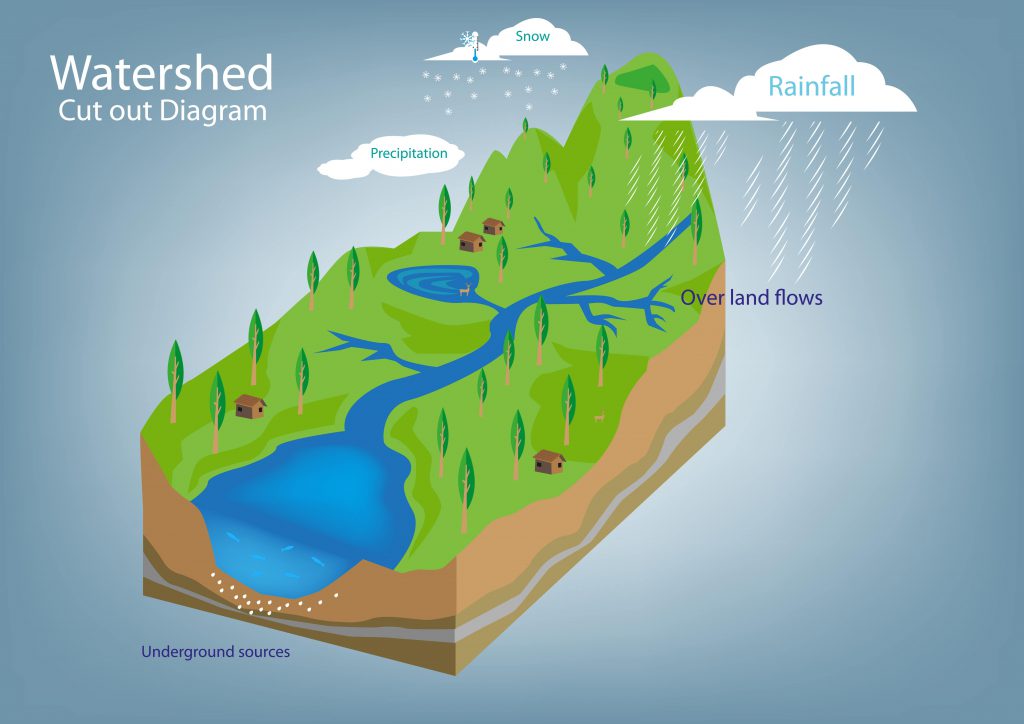Water Systems
The first step in thinking about water is to understand the hydrologic cycle, which involves rainfall, evaporation, cloud formation, overland runoff, and groundwater that drains into the ocean. View the image below to see this system.

Watersheds
A watershed is the area of land that drains to one specific point, such as a lake, bay, ocean, stream, or river. Everyone lives in a watershed. If rain at your location would flow into a nearby stream, even if that stream is dry most of the year, you are part of its watershed.
The EPA has a tool called Surf Your Watershed that helps you locate and understand the conditions of your watershed.
In addition to the water you drink, your watershed provides water for other species—plants and animals. It is crucial for water managers and the public to remember that water is required for every living thing, from the tiniest organisms to the largest. All animals need water to drink and to support the vegetation for their habitat and food source.
If there is a drought, or if we remove too much water and make a river or stream dry, fish and other aquatic organisms cannot survive. Similarly, plants and trees require a certain amount of water to grow. When a wetland is drained, its vegetation will change and the birds and animals that depend on the trees, plants, and a moist environment will be forced elsewhere in order to survive.
To learn more about your area’s water resources and get involved in your watershed, join a local watershed or water protector group. These groups celebrate their waterways with varied actions, such as sponsoring boating and fishing recreational activities, monitoring water quality, organizing trash cleanups, and building and maintaining trails. Members act as advocates for protecting and improving the nearby rivers and land.
Changing Water Resources
Climate scientists predict that normal patterns of rainfall, streamflow, and flooding will all change in coming years. The severity and frequency of both drought and flood is expected to increase as the Northeast United States receives more and more precipitation and the Southwest receives less and less. Spring snowmelts are also developing earlier in the year. The conditions that affect rates of evaporation, such as air temperature, solar radiation, wind, humidity, and water availability, are all undergoing change, which in turn affect soil moisture, groundwater recharge, and runoff.
Floods of all kinds are expected to increase across certain regions of the U.S., including flash floods and floods in urban areas. Places that have large areas of impervious surfaces, such as cities, will also experience a lot of runoff in floods, which can overwhelm old infrastructure and water storage facilities.
On the other hand, areas dealing with drought are already struggling to provide water for their communities. Water shortages cause a wide range of economic effects as well, as farms have difficulty watering their crops. Taking steps like purchasing desalination equipment and thinking ahead about how to prepare for drought situations increases the resiliency of communities in the face of drought.
While some impacts of changing water resources are obvious, like the increased difficulty of getting water to residents in a community, there are a wide range of effects that might not be clear at first.
Water impacts energy, from the standpoint of both production and usage. Water is involved in generating energy in hydroelectric dams, producing steam in thermoelectric power plants, and cooling reactors in nuclear power plants. All of these functions will be affected as our access to water changes. Water treatment and distribution also requires energy at all steps of the process, and will require more energy as water becomes more difficult to access in some areas.
Water resources also impact the ecosystems around us that we rely upon for food, wildlife habitat, protection from flooding, and so much more. Both too little and too much water can have huge impacts on ecosystems as we know them today. As we adapt to new climate conditions, it is important to keep in mind how the environment we live in will change as well.
Impermeable Surfaces
In urban and suburban areas, the water we use in our homes and businesses is usually provided by a water utility. Reservoirs, rivers, and wells are common sources, which are treated to make the water safe for drinking before it is delivered to customers through a network of pipes.
Impermeable surfaces are barriers to natural water flow commonly associated with buildings and roads. Street pavement, parking lots, driveways and sidewalks, as well as building roofs are all impermeable surfaces. They are important because the flow of water from these surfaces can contribute to pollution as stormwater carries pollutants into waterways.
Pollutants from stormwater can include:
- Oil, grease, and fluids from vehicles
- Fertilizer, herbicides, and other garden chemicals
- Bacteria from pet waste and failing septic systems
- Soil from construction sites
- Soap from equipment washing
- Accidental spills and leaky containers
- Street litter, such as fast-food wrappers and drink containers
There are ways we can reduce water runoff at home as well as community development initiatives that can help.
Actions
- Explore Surf Your Watershed to understand your local water system
- Learn how pesticides affect water quality
- Make changes at home to support a healthy water system